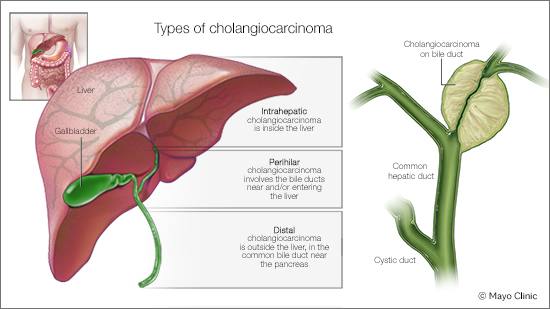-
Cancer
Mayo Clinic Q and A: What is cholangiocarcinoma and how is it treated?

DEAR MAYO CLINIC: My mother has been experiencing unusual and persistent fatigue, abdominal pain, and jaundice. After undergoing a CT scan, her doctor diagnosed her with cholangiocarcinoma. What is this type of cancer? And what treatment options are available?
ANSWER: Cholangiocarcinoma is a rare cancer that develops from the bile ducts, which are slender tubes that carry the digestive fluid bile and connect the liver to the gallbladder and small intestine.
The tumor can occur anywhere along the biliary “tree” and is divided into three subtypes based on where it starts. The intrahepatic subtype starts in the bile duct inside the liver and typically appears as a mass in the liver, which may affect the organ’s function. The second subtype, called perihilar cholangiocarcinoma, occurs just outside of the liver, where the bile ducts come together and exit the liver. Patients diagnosed with this form of cholangiocarcinoma typically present with jaundice. Distal cholangiocarcinoma is the third subtype. It occurs in the portion of the bile duct that is outside of the liver and nearest to the intestine. This subtype also typically presents with jaundice.
An initial CT scan can be suggestive of cholangiocarcinoma, but additional testing, including a biopsy or brushings, is required to establish the diagnosis and the stage. For all three subtypes, a health care professional typically also will order a CT scan of the chest to look for any signs of metastasis, or spread, to the lungs.
If there is blockage of the bile ducts and jaundice, symptoms most commonly occurring with the perihilar or distal subtypes, then a health care professional may perform an endoscopic evaluation with an endoscopic retrograde cholangiopancreatography. This allows for collection of a sample of the area of concern and placement of an internal stent to open the bile ducts so the liver can drain appropriately. Biliary drainage helps relieve signs and symptoms of biliary blockage, which can include jaundice, poor appetite and itching.
For intrahepatic tumors that present as a liver mass, it is common to have an ultrasound-guided biopsy performed by a radiologist to establish the diagnosis and obtain tissue for further testing, such as sequencing studies.
There are several options for treating these rare tumors, but determining the optimal approach for your mother will depend on the stage, location and subtype of her tumor. For example, most patients with localized disease, meaning the cancer has not spread to any other organs, are candidates for surgery to remove the tumors.
If your mother is diagnosed with intrahepatic or perihilar cholangiocarcinoma, removing part of the liver may be required. However, standard surgical approaches to remove the tumor may not be possible for some patients diagnosed with perihilar cholangiocarcinoma. In certain situations, a liver transplant may be an option instead.
Finally, the most common surgery to treat distal cholangiocarcinoma is called the Whipple procedure, which is a complex operation that involves removing a portion of the pancreas.
Surgery is the only curative treatment option for these tumors, but for those patients who are not candidates for surgery, other treatment options should be considered. These include chemotherapy, targeted therapy, immunotherapy, radiation and radioembolization. These treatments often are given in combination, and the combination and order of the treatments is dependent on the specific tumor subtype and extent of the disease.
As part of the testing for patients diagnosed with cholangiocarcinoma, it is now common to perform an analysis for mutations, called next-generation sequencing. These tests can identify certain mutations in tumors for which we have targeted therapy options, and these mutations occur more frequently in intrahepatic cholangiocarcinoma.
Finally, for patients who have not responded to standard treatments or have tumors that have progressed on standard treatments, we recommend considering enrollment in clinical trials evaluating new treatment strategies.
Ultimately, if your mother has been diagnosed with cholangiocarcinoma, it is important that she be seen at a cancer center with experience treating these tumor types because the treatment options, and determining which patients are candidates, is complex. — Dr. Rory Smoot, Surgery, Mayo Clinic, Rochester, Minnesota
****************************
Related Article
- Consumer Health: Treating liver cancer published 10/27/22







